Results: California Cabbage Organic Variety Trial, 2015 - Organic Seed Alliance
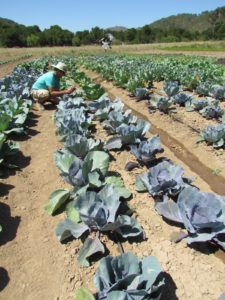
Publication date: March 15, 2018
Author: Steve Peters, Organic Seed Alliance
Funder: Gaia Fund
Table of Contents
- Introduction
- Material and Methods
- Discussion and Results
- Description of Green Cabbage Varieties
- Description of Red Cabbage Varieties
- Summary
Introduction
Round, early-maturing red or green cabbage produced for the summer and fall fresh market can be a valuable niche crop for produce growers. Its relatively short maturity provides flexibility throughout the season for planting and harvesting. In milder climates these crops can also be over-wintered successfully.
This trial was conducted to evaluate the performance of several of the best open-pollinated (OP), public domain cabbage varieties available along with a few leading commercial hybrids. Results from this study will help decide which of these OPs are most worthy of further development and improvement for wider use by organic market growers.
Materials and Methods
The trial was conducted on land farmed by professional seedsman Ronald Welten in an isolated field about 2 miles west of Gilroy, California. The site is situated alongside a year-round creek and the soil is a well drained, silty clay loam.

See Table 1 for high and low temperatures and rainfall for Gilroy during the months that the cabbages were grown. Rainfall was negligible during this time and drip irrigation was used.
Of 14 cabbage varieties evaluated, 10 were OPs and four were F1 hybrids. The varieties ranged from early to mid maturity and are categorized as either fresh market round-red and or fresh market round-green. See Table 2 for a list of varieties, source, and ownership status.
On February 3, 2015, seeds were sown into 72-cell trays at Headstart Nursery in Gilroy, CA. On March 31, the transplants were planted into the field into two-row beds with 2 ft. between rows. Plants were placed 18 in. apart within a row. Each plot was 20 bed-ft. long (i.e., 40 row-ft.). Each variety was replicated twice in the field, so 52 seedlings of each variety were planted. Two exceptions were the varieties Columbia and Mammoth Red Rock, with only 35 and 25 seedlings planted, respectively.
Table 1. Monthly average high and low temperatures and rainfall – Gilroy, CA, March – July 2015
| April | May | June | July | |
| High Temp (F°) – 2015 | 69 | 67 | 82 | 84 |
| Average High | 73 | 79 | 84 | 885 |
| Low Temp (F°) – 2015 | 44 | 45 | 51 | 51 |
| Average Low | 45 | 49 | 53 | 55 |
| Rainfall (in.) – 2015 | 0.68 | 0 | 0 | 0 |
| Average | 1.26 | 0.47 | 0.12 | 0 |
Source: US Climate Data
Gilroy, California: Longitude – 121.561, Latitude – 37.003
Table 2. Seed varieties
| Round Green Cabbage | |||
| Variety | Source | Ownership Status | Days to Maturity* |
| Capture F1 | Johnny’s Selected Seeds | Proprietary, Bejo Seeds | 87 |
| Columbia | Nash’s Organic Produce | Public Domain | 67 |
| Copenhagen Market | Sand Hill Preservation | Public Domain | 65 |
| Early Bird | Meadowlark Hearth | Public Domain | 60 |
| Early Flat Dutch | Southern Exposure Seed Exchange | Public Domain | 85 |
| Farao F1 | Johnny’s Selected Seeds | Proprietary, Bejo Seeds | 65 |
| Golden Acre | Southern Exposure Seed Exchange | Public Domain | 62 |
| Primax | High Mowing Organic Seeds | Public Domain | 60 |
| Round Red Cabbage | |||
| Variety | Source | Ownership Status | Days to Maturity* |
| Integro F1 | Johnny’s Selected Seeds | Proprietary, Bejo Seeds | 85 |
| Red Acre | Southern Exposure Seed Exchange | Public Domain | 76 |
| Red Express | Nash’s Organic Produce | Public Domain | 63 |
| Amarant | Meadowlark Hearth | Public Domain | 75 |
| Mammoth Red Rock | Seed Savers Exchange | Public Domain | 98 |
| Super Red 80 F1 | Johnny’s Selected Seeds | Proprietary, Sakata Seeds | 85 |
* This is the number listed by the seller of that variety
Discussion and Results
Initial field observations were made on April 24. All transplants (25 days old) looked relatively healthy except for a few weak and small plants that were removed. Some flea beetle damage was observed throughout the field. It was likely caused when higher than normal temperatures (above 80°F) occurred one week after transplanting and lasted for a few days. Throughout the remainder of April and all of May much cooler than normal temperatures (<60°F) persisted, causing slower than expected growth. While the plants were still very young (four to seven leaves per plant across the trial), distinct maturity classes among the varieties could be clearly identified.
Early maturing: ‘Early Bird’, ‘Farao’, ‘Primax’
Mid maturing: ‘Capture’, ‘Columbia’, ‘Copenhagen Market’, ‘Early Flat Dutch’, ‘Golden Acre’, ‘Integro’, ‘Red Acre’, ‘Red Express’
Late maturing: ‘Amarant’, ‘Mammoth Red Rock’, ‘Super Red 80’
Detailed observations and photographs were taken on June 9, June 16, June 23, July 2, July 10, July 12, and July 17. This was the period of time (from 70 to 108 days after transplanting) in which the cabbage heads matured and were marketable. The days to maturity (DTM) for all the varieties in this trial were significantly greater than the published values by the companies that sell this seed (See Table 2). While the local conditions may have factored into the longer maturity time, the seed company values are likely the most optimistic estimates for only a few precocious individual plants in the population. Conducting your own trials is the only way to really know the actual period of time required.
The importance of having at least two replications of each variety was clearly illustrated in this trial. One portion of the field happened to receive much less water than other areas due to a malfunction in the drip system. As a result, the plants of the varieties growing in that area were smaller, weaker, and more infested with aphids.
On June 9 (70 days after transplanting), all plants were rated for their degree of maturity. The percentage of plants for each variety that had a 2-inch head diameter or greater was tabulated. Table 3 illustrates the difference in maturity between both replications for each variety. The five varieties with the greatest maturity difference between the two reps happened to be located in the area of the field that received very little water. We inferred that lack of water caused weaker plants, which delayed maturity. Therefore, for the subsequent analysis of each variety, the information from those five poorest (latest-maturing) reps was discarded, and only the results of the “good” rep were considered. These “single-rep” varieties were ‘Capture’, ‘Early Bird’, ‘Integro’, ‘Red Express’, and ‘Super Red 80’. Table 4 summarizes the rate of maturity. At that time about 40% of ‘Early Bird’ cabbage heads were marketable, while no other variety had any mature heads.
Table 3. Comparing replications by evaluating maturity – June 9, 2015
| Variety | # of plants, rep 1 | *of plants w/>2″ diameter head, rep 1 | % of plants w/>2″ diameter head, rep 1 | # of plants, rep 2 | # of plants w/>2″ diameter head, rep 2 | % of plants with >2″ diameter head, rep 2 | % difference between reps |
| Capture* | 26 | 8 | 31% | 22 | 0 | 0% | 31% |
| Columbia | 11 | 3 | 27% | 20 | 4 | 20% | 7% |
| Copenhagen Market | 26 | 1 | 4% | 22 | 2 | 9% | 5% |
| Early Bird* | 22 | 17 | 77% | 22 | 1 | 5% | 73% |
| Early Flat Dutch | 25 | 0 | 0% | 23 | 4 | 17% | 17% |
| Farao | 26 | 13 | 50% | 24 | 14 | 58% | 8% |
| Golden Acre | 25 | 15 | 60% | 25 | 16 | 64% | 4% |
| Primax | 23 | 14 | 61% | 26 | 22 | 85% | 24% |
| Integro* | 22 | 6 | 27% | 18 | 0 | 0% | 27% |
| Red Acre | 20 | 9 | 45% | 23 | 5 | 22% | 23% |
| Red Express* | 21 | 14 | 67% | 24 | 2 | 8% | 58% |
| Amarant | 24 | 10 | 42% | 20 | 6 | 30% | 12% |
| Mammoth Red Rock | 11 | 0 | 0% | 12 | 0 | 0% | 0% |
| Super Red 80* | 25 | 4 | 16% | 25 | 17 | 68% | 52% |
*Varieties with > 25% difference rate of maturity between replications. Eliminated slower maturing rep of these varieties in subsequent analysis.
Table 4. Maturity ranking – earliest to latest, June 9, 2015
| Variety | Color | % of plants w/>2″ diameter head |
| Early Bird* | green | 77% |
| Primax | green | 73% |
| Super Red 80* | red | 68% |
| Red Express* | red | 67% |
| Golden Acre | green | 62% |
| Amarant | red | 36% |
| Farao | green | 34% |
| Red Acre | red | 33% |
| Capture* | green | 31% |
| Integro* | red | 27% |
| Columbia | green | 23% |
| Early Flat Dutch | green | 8% |
| Copenhagen Market | green | 6% |
| Mammoth Red Rock | red | 0% |
*Included only the healthier and faster maturing replication

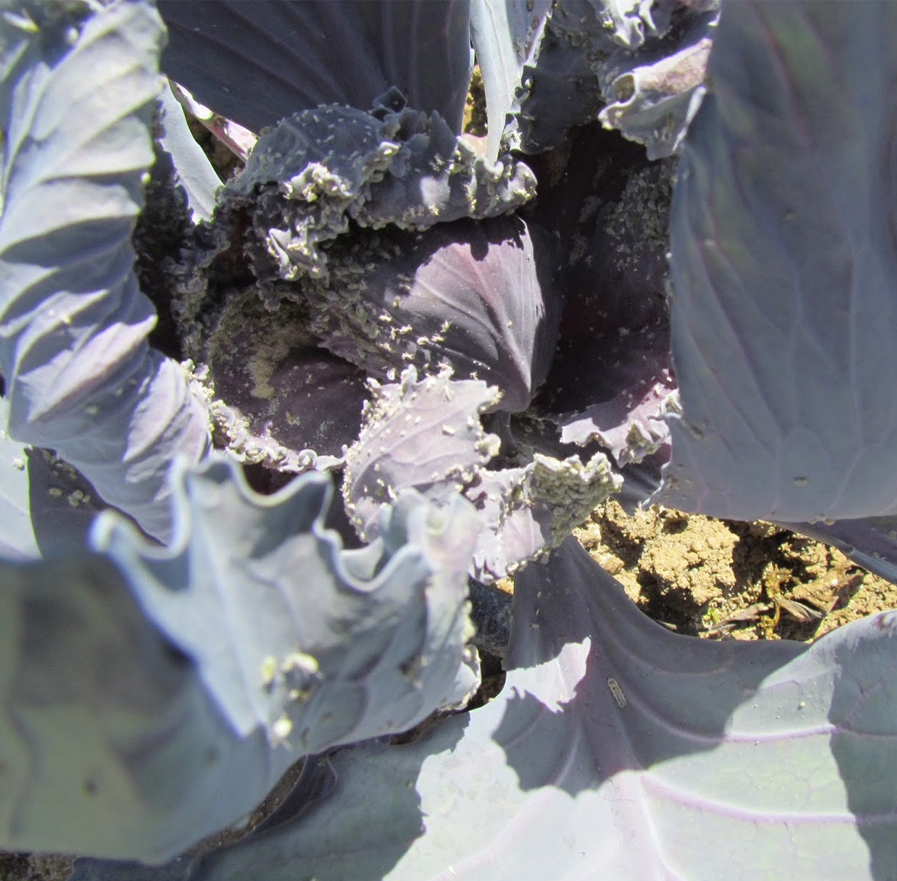
Figures 1 and 2 depict the rate of maturity for the green and red varieties, respectively, over a 5-week period. Clearly maturity classes, from early to late, range widely among the varieties in this trial.
Figure 1. Progression of maturity for 8 green cabbage varieties
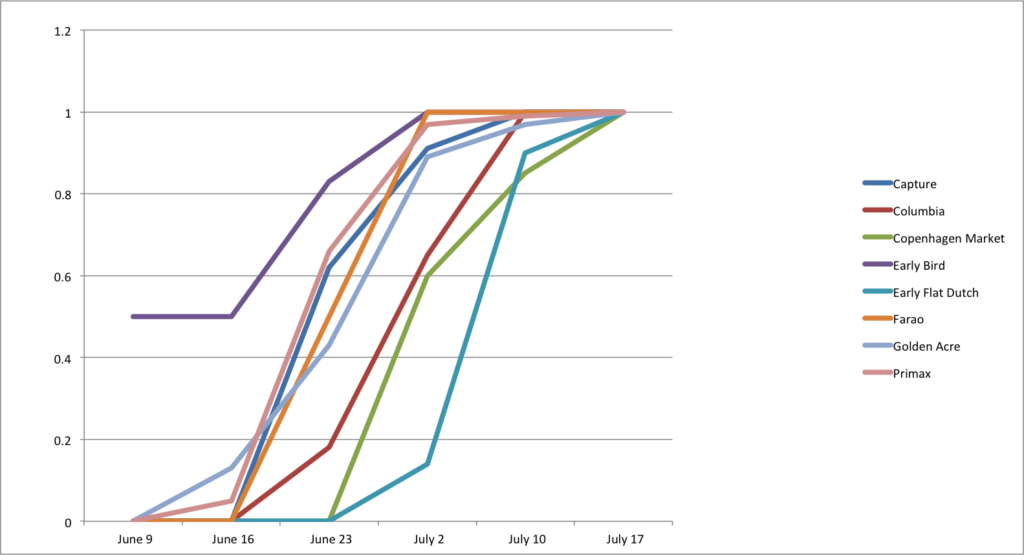
Figure 2. Progression of maturity for 6 red cabbage varieties
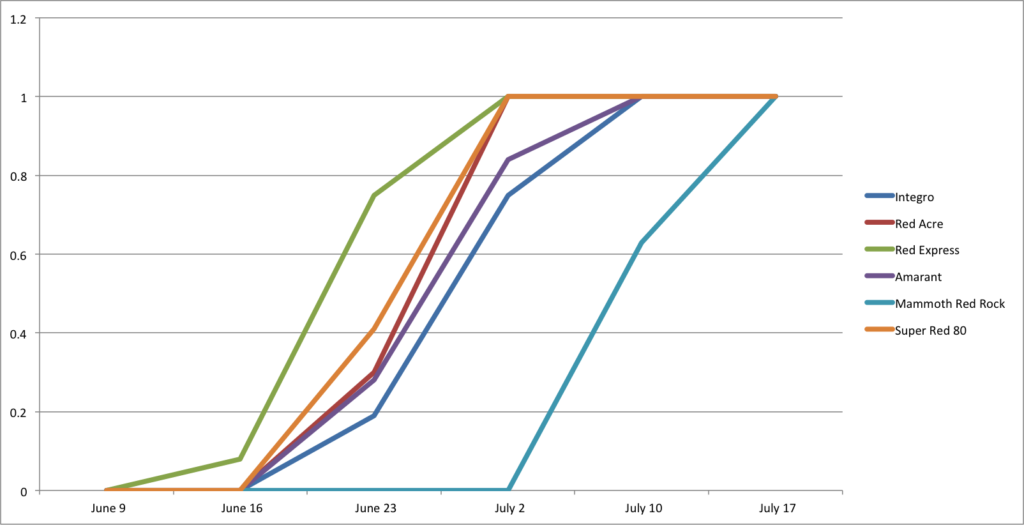
Description of Green Cabbage Varieties
Table 5 summarizes the key traits for each variety, and Table 6 summarizes some raw tasting evaluations.
Table 5. Summary of traits
| Green Cabbage | Relative maturity | Average head weight (lb) | Core length (in) | Core width at base (in) | Head diameter (in) | Head height (in) | Degree of roundness (hgt/wid) | Aphid resistance* | Shape description |
| Capture | early-mid | 5.54 | 3.00 | 1.38 | 8.00 | 6.25 | 0.78 | 4 | slightly flattened |
| Columbia | mid | 1.94 | 2.50 | 1.00 | 5.25 | 5.38 | 1.02 | 8 | round |
| Copenhagen Market | mid-late | 2.94 | 2.50 | 1.50 | 6.25 | 6.00 | 0.96 | 5 | round |
| Early Birds | very early | 2.74 | 2.25 | 1.00 | 4.50 | 5.50 | 1.22 | 7 | slightly elongated |
| Early Flat Dutch | late | 3.31 | 2.50 | 1.75 | 7.50 | 4.50 | 0.60 | 1 | flattened |
| Farao | early | 2.23 | 2.50 | 1.00 | 5.00 | 5.25 | 1.05 | 6 | round |
| Golden Acre | early-mid | 3.34 | 2.75 | 1.38 | 6.50 | 6.00 | 0.92 | 9 | round to slightly flattened |
| Primax | early | 2.00 | 1.25 | 1.00 | 5.50 | 6.50 | 1.18 | 8 | slightly elongated |
| Red Cabbage | |||||||||
| Integro | mid | 2.85 | 3.25 | 1.50 | 5.75 | 5.75 | 1.00 | 2 | round |
| Red Acre | early | 1.81 | 2.25 | 1.00 | 5.00 | 4.00 | 0.80 | 8 | slightly flattened |
| Red Express | very early | 1.76 | 2.00 | 1.25 | 4.50 | 4.50 | 1.00 | 7 | round |
| Amarant | mid | 3.11 | 3.00 | 1.25 | 6.25 | 6.50 | 1.04 | 8 | round |
| Mammoth Red Rock | late | 2.56 | 3.75 | 1.38 | 6.50 | 6.00 | 0.92 | 5 | round to slightly flattened |
| Super Red 80 | early | 2.43 | 3.00 | 1.50 | 6.00 | 5.50 | 0.92 | 5 | round to slightly flattened |
*9=excellent; 1=poor
Table 6. Fresh cabbage tasting*
| Variety | Comments – July 15, 2015 | Comments – August 4, 2015 |
| Capture | very dry, not sweet, a little peppery | dry, pepper aftertaste, soapy, off-flavor |
| Columbia | more peppery, drier, good crunch | sweet, crisp, mild, juicy, no peppery flavor |
| Copenhagen Market | sweet, not much bite | watery, not much flavor, not crisp |
| Early Bird | more watery (iceberg lettuce replacement), bland, no bite | crips, juicy, mild, not much flavor |
| Early Flat Dutch | dry, poor flavor, radishy | |
| Farao | mild cabbage flavor | |
| Golden Acre | sweet, a little peppery, juicy, moist, good balance, best flavor | mild, sweet, slightly cabbagey flavor |
| Primax | bland flavor, not as sweet as Copenhagen Market | watery, sweet turnip-like flavor, slight nasturtium taste |
| Integro | dry, flavorless | |
| Red Acre | crisp, juicy, mildly sweet, slight nasturtium-like flavor | |
| Red Express | dense, hard, dry, mildly sweet flavor, slightly peppery | |
| Amarant | mild, slightly peppery, pleasant flavor | |
| Mammoth Red Rock | spicy flavor, OK texture | |
| Super Red 80 | very mild, pleasant flavor |
*Tasters were Steve and Moria Peters
Primax: A modern OP in the public domain, it was notable for having a very high percentage of marketable heads. Most heads were 1.5 to 2 lb., although one head weighed in at almost 4 lb. It seemed particularly consistent for an OP. ‘Primax’ made nice oval heads, which varied in terms of density. Tasting it after three weeks in cold storage, we found it to be rather watery, with a sweet turnip flavor and overtones of nasturtium.
Early Bird: This modern, public domain OP was a product of European biodynamic farmer breeding. ‘Early Bird’ was five days earlier than the next earliest varieties, and was remarkably free of aphids. It made petite, extremely dense, oval heads of 1.5 to 2.5 lb., although a single large exceptional head was weighed at over 4 lb. It had a good texture: crisp and juicy, and was very mild, with little flavor.
Golden Acre: This venerable, heirloom OP in the public domain was my favorite of all the green cabbages based on its overall field performance. It had the least number of aphids of all varieties. A very high percentage of the heads were nicely formed and marketable, although the size varied greatly from 1.5 to nearly 6 lb. It had some of the earliest heads, harvestable only a few days after ‘Early Bird’, but it also had some later-maturing heads, giving it one of the longest harvest windows. ‘Golden Acre’ produces attractive, round to slightly flattened, reasonably tightly packed, firm heads with good texture, and a mildly sweet, slightly mustardy flavor.
Capture: This F1 hybrid, developed and owned by Bejo Seeds, produced very consistent, slightly flattened heads from 2.5 lb. and up, with most reaching 6 to 7 lb. Overall yield was the highest in the trial, despite being fairly susceptible to aphids. It matured two to three weeks later than ‘Early Bird’. When cut open, the interior was less tightly filled out than optimal. Eating quality was only fair at best, as the texture was very dry, and it had a soapy off-flavor and a somewhat unpleasant peppery aftertaste.
Early Flat Dutch: A classic heirloom OP in the public domain, it formed medium-sized, flattened heads, averaging just over 3 lb., although most heads were not well filled out. As this is really a fall/winter variety, it needed cooler conditions to perform up to its potential, where head size may be two to three times larger. In the trial environment it was particularly affected by aphids, which apparently found it delicious. Unfortunately, our tasters did not. It had a flavor generally characterized by the tasters as “nasty”: dry, bitter radish, off-taste. Overall it was a poor performer in this trial.
Farao: This modern F1 hybrid produced quite uniform, fairly small, compact and very round heads, which matured two weeks later than ‘Early Bird’. Some early heads weighed 1.5 lb., but most of the heads averaged 3 lb. It had moderate to light pressure from aphids. Flavor was mild and pleasant. This variety sets a standard with which to measure worthy early-maturing, open-pollinated, green cabbage varieties.
Copenhagen Market: A public domain, heirloom OP, it had round, firm heads averaging about 3 lb. Aphid damage was fairly light, and maturation was three weeks later than ‘Early Bird’. Its eating quality was poor: watery, lacking flavor, and not crisp. ‘Copenhagen Market’ looks promising, from a field and marketing view, but the flavor and texture need improvement.
Columbia: A modern OP in the public domain, ‘Columbia’ was improved by Washington produce and seed grower Nash Huber. It is a particularly attractive cabbage with extremely firm, very round heads, a distinctive rose blush, and minimal aphid pressure. It matured about two weeks after ‘Early Bird’ and weighed from 1.5 to nearly 3 lb. It was crisp and juicy, with a mild sweetness and no peppery aftertaste. Overall this ranked as one of the best of the green cabbage varieties.
Description of Red Cabbage Varieties
Super Red 80: This F1 hybrid was developed and is owned by Sakata Seeds. It did suffer from moderate aphid pressure, but had a very high percentage of marketable heads and was one of the earliest-maturing varieties. Some early heads were 1.5 to 2 lb. Later on, the heads were consistently 3.5 to 4 lb. This cultivar is a clear standard of excellence in this category, and sets the bar for improving open-pollinated breeds. It had a very mild but pleasant flavor. ‘Super Red 80’ is perfectly round and tightly packed and is definitely a market winner.
Amarant: A modern OP in the public domain, ‘Amarant’ was developed by biodynamic farmers from Bingenheim Seeds in Germany. This was a trial favorite, as it possessed a luminous stainless steel-like sheen on richly-hued, red-violet leaves. It developed a reliably rock-hard, dense head that was slightly ovoid, suffered almost no damage from aphids, and had a large percentage of marketable heads. A few heads matured in mid-June, but many weren’t ready for another three to four weeks, so its harvest window was 7-10 days longer than ‘Super Red 80’. Head weight ranged from 1.5 to over 5 lb. It had a mild, slightly peppery, pleasant flavor and a crunchy, juicy texture. Overall this was the top OP variety.
Red Acre: This old reliable OP in the public domain was quite impressive in the trial. It produced moderately small, well-formed heads from 1.5 to 2.5 lb. and suffered the least amount of aphid damage of all the red varieties. Notably, the inner head color of ‘Red Acre’ was an unusual glowing bright lilac. It was crisp and juicy, with mild sweetness and a slight nasturtium taste, making it one of the best for eating. Unfortunately, most of the heads did not fill out well. They were asymmetrical, soft in some spots, and suffered some tissue damage from subsequent refrigerated storage.
Mammoth Red Rock: This is a beautiful OP, public domain heirloom that has become quite rare. The attractive oval heads were 1.5 to 3.5 lb., very dense and tight, although the core was rather large. Aphid damage was was moderate. Most significantly, ‘Mammoth Red Rock’ was by far the latest maturing of all the cabbages in this trial. In fact, by mid-July when all the other varieties were finished, 50% of the heads were still immature. The flavor was a bit spicy and mustardy, although not unpleasant, and the texture was decent. This variety is better suited for longer season conditions.
Integro: This F1 hybrid was developed and is owned by Bejo Seeds. ‘Integro’ had uniformly attractive deep red-violet, perfectly round heads weighing 2 to 3.5 lb. The heads were fairly dense, but the core was larger than most others. Also, this variety had a rather heavy infestation of aphids. For fresh consumption, the texture was notably dry and it had almost no flavor. From a production and marketing standpoint it was a pretty good but not a great variety.
Red Express: This modern, public domain OP has most recently been selected and improved by farmer/breeder Nash Huber of Nash’s Organic Produce. It was very early-maturing, just a few days after ‘Early Bird’. It had low aphid pressure, and the heads were relatively small at around 1.5 to 2 lb. ‘Red Express’ heads are bright red-violet, very round, and rock-hard. The texture was quite hard and dry, but it had a sweet, mildly peppery flavor that made it a good eater. ‘Red Express’ is one of the best early OP reds available.
Image gallery of trial varieties in the field and inner core view
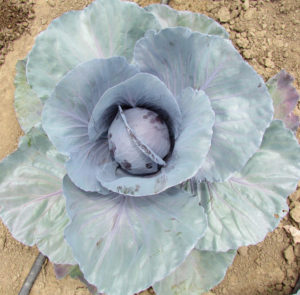
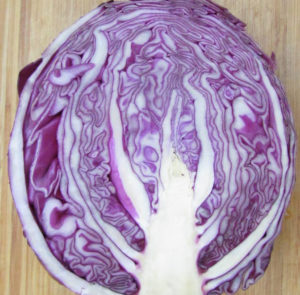
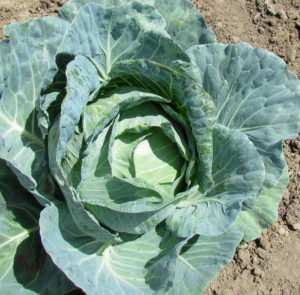
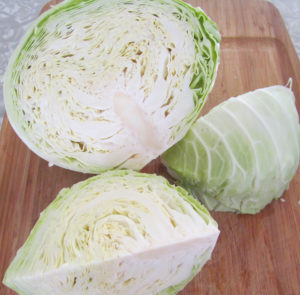
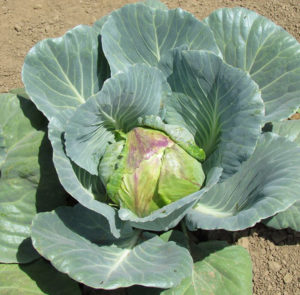
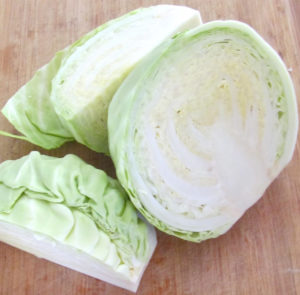
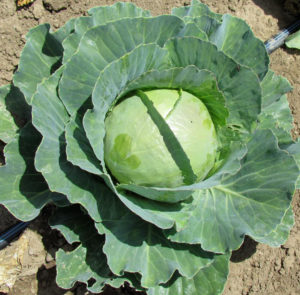
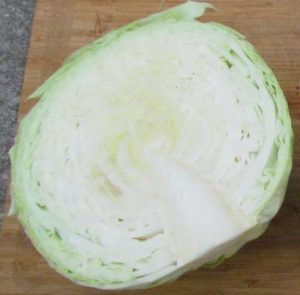
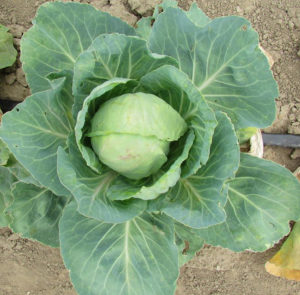
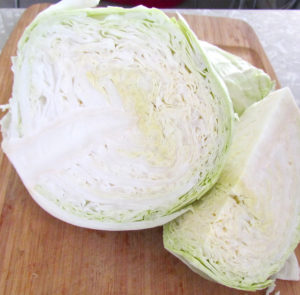
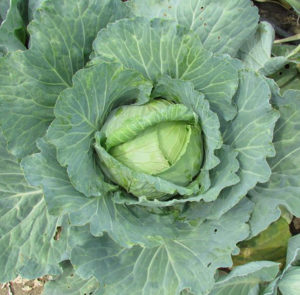
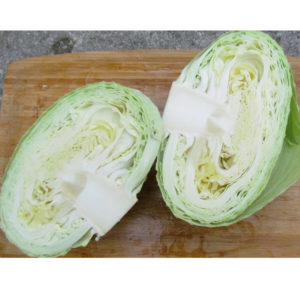
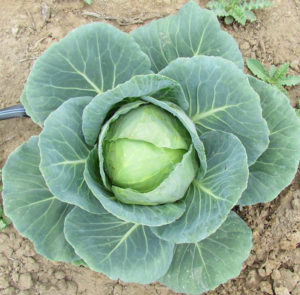
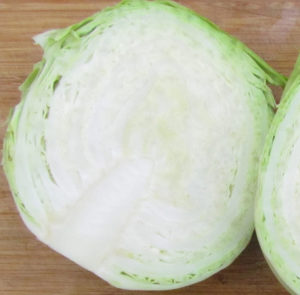
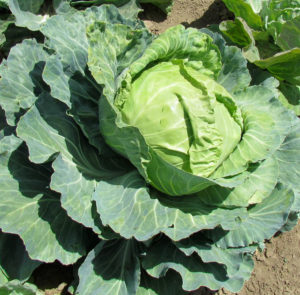
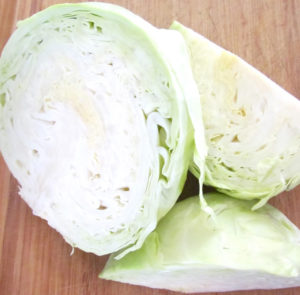
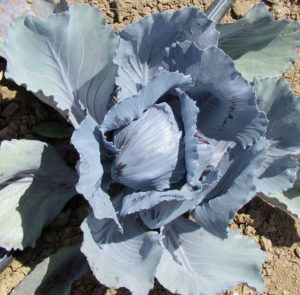
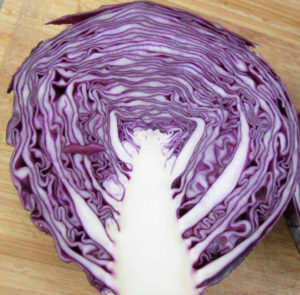
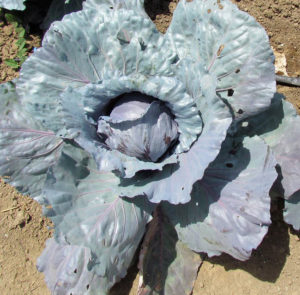
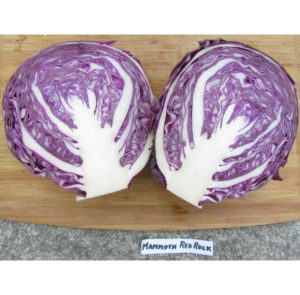
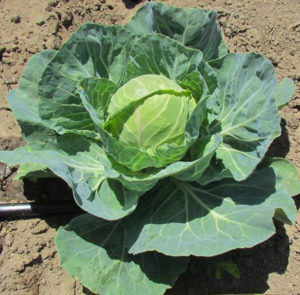
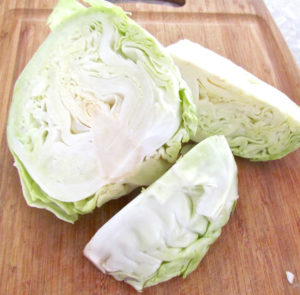
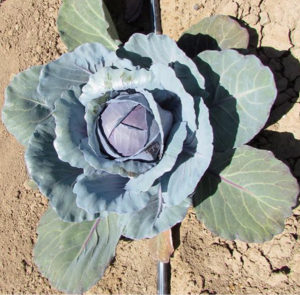
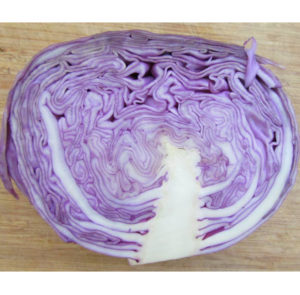
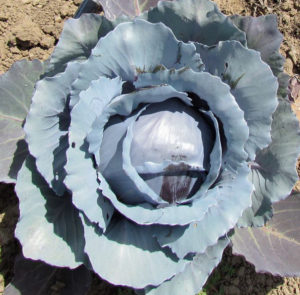
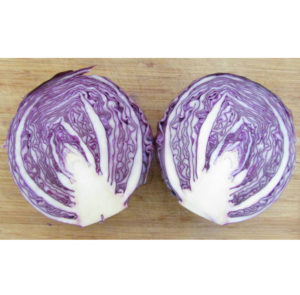
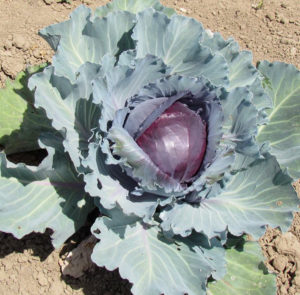
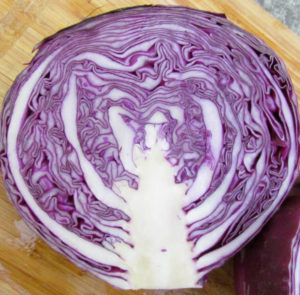
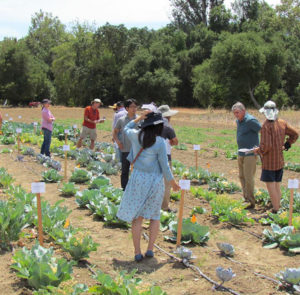
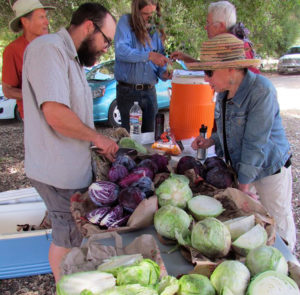
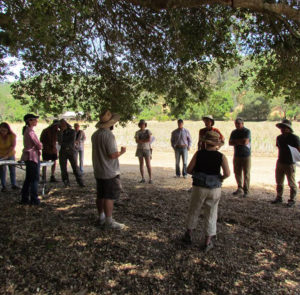
Summary
The purpose of this trial was to identify specific domain, open pollinated, fresh eating cabbage cultivars that would be suitable for 1) producing commercial quantities for organic market growers, and 2) making further selections and improvements that would benefit farmers and gardeners alike. Because flavor information was limited, we cannot conclusively evaluate eating quality. Therefore, varietal assessment from this trial was primarily based on phenotypic traits — size, shape, color, and agronomic characteristics including days to maturity, aphid resistance and overall vigor. Listed below are the varieties that appear to have the most potential going forward. Varieties of each type are ranked by head quality, and the need for further improvement is noted.
Green Cabbage:
- Columbia – excellent quality heads, although later maturing than others. Requires very little selection.
- Golden Acre – excellent quality heads but variable size and maturity dates. Recommend selection/improvement before larger production.
- Primax – good quality heads with consistent earliness. Requires very little selection.
- Early Bird – good quality heads with consistent earliness. Requires very little selection.
The other green OP cabbages – ‘Late Flat Dutch’ and ‘Copenhagen Market’, mature too late to be considered in this class type.
Red Cabbage:
- Amarant – excellent quality heads. Requires very little selection
- Red Express – good quality heads. Requires very little selection
- Red Acre – good quality heads but inconsistent. Needs selection/improvement
The other red OP cabbage – ‘Mammoth Red Rock’, matures too late for this class type.

